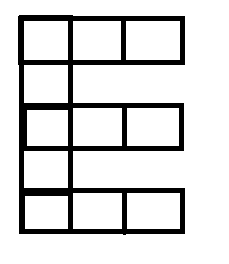A-BILLI : Creating Problems on me ?
 The letters
{
A
,
B
,
I
,
L
,
L
,
I
}
are placed in the boxes of the above figure. How many distinct ways exist for placing the letters so that no row remains empty.
The letters
{
A
,
B
,
I
,
L
,
L
,
I
}
are placed in the boxes of the above figure. How many distinct ways exist for placing the letters so that no row remains empty.
Join the Brilliant Classes and enjoy the excellence.
The answer is 14580.
This section requires Javascript.
You are seeing this because something didn't load right. We suggest you, (a) try
refreshing the page, (b) enabling javascript if it is disabled on your browser and,
finally, (c)
loading the
non-javascript version of this page
. We're sorry about the hassle.
2 solutions
Good solution .
Did the same thing :)
There are two ways of doing combination problems
-
By adding different possibilities taking into account the constraints
-
By taking the total and subtracting what is not possible
I have done it by first method
There are 5 rows and 6 letters so one row will have 2 letters and others 1 letter each
A, B - Dissimilar Letters
I, I and L,L - Similar Letters
Case I: Two letters which come in the same row are similar (either I, I or L,L)
L1= 2 (Selecting first two) × 3 (Arranging first two) × 3 × 3 (Selecting places for remaining four) × 2 ! 4 ! (Arranging the remaining 4)
Case II: Two Letters which come in the same row are dissimilar (A, B)
L2= 1 × 3 × 2 × 3 × 3 × 2 ! 2 ! 4 !
Case III: Two Letters which come in the same row are 1 similar and other dissimilar (one from A,B and other from I,L)
L3 = 2 × 2 × 3 × 2 × 3 × 3 × 2 ! 4 !
Case IV: Two Letters which come in the same row are dissimilar but from the similar group (I and L)
L4= 1 × 3 × 2 × 3 × 3 × 4 !
Add all and multiply by 3 since there are three rows where 2 letters are possible
Total = 3 × ( L 1 + L 2 + L 3 + L 4 )
= 14580
Since there are 6 letters, one row must have 2 letters on it and there are 3 possible rows for the placement of those two letters.
First let's choose 6 boxes for the letters. The number of ways to do this is (number of rows with 3 boxes) x (number of ways to choose two boxes from a row of three boxes) x (number of ways to choose a box from a row of three boxes) = 3 x 3 x 3^2 (squared since we must get one box each from the other 2 rows) = 81
Next step is finding the number of ways to arrange the six letters into these 6 boxes that we chose earlier. The number of ways to do this is 6!/(2! x 2!) (because there are 2 I's and 2 L's) = 180
Therefore to get the number of distinct ways to place the 6 letters in the figure such that no two row remains empty is just the product of the two numbers we get which is 81 x 180 = 14580